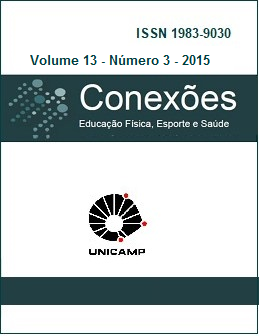Abstract
The term motor development is employed in studies that seek to understand the
development processes of human movement. The process of motor development occurs
according biological standards also by the influence of external factors. The aim of this
study was to review this important considerations about motor development based on the
work of Gallahue, Ozmun and Goodway and the influence of environment and
socioeconomic status on motor development of children. Collected studies were
investigated in period September 2013 to February 2014 on the basis of Google Academic,
Scielo and Ebsco. A review of studies reinforces the family environment and
socioeconomic status can influence the infant motor development.
References
GALLAHUE, D. L.; OZMUN, J. C.; GOODWAY, J. Compreendendo o desenvolvimento motor: bebês, crianças, adolescentes e adultos. Porto Alegre: AMGH, 2013.
REED, E. S.; BRIL, B. The primacy of action in development. In: BERNSTEIN, N. A. Dexterity and its development. Dinamarca: Lawrence Erlbaum Associates, 1996. p. 431-451.
ADOLPH, K. Learning to keep balance. Advances in child development and behavior, San Diego, v. 30, p. 1-40, 2002.
BERGER, S. E.; THEURING, C.; ADOLPH, K. E. How and when infants learn to climb stairs. Infant Behavior and Development, v. 30, n. 1, p. 36-49, feb. 2007.
DAVIS, B. E. et al. Effects of sleep position on infant motor development. Pediatrics, Evanston, v. 102, n. 5, p. 1135-1140, nov. 1998.
NORDBERG, L.; RYDELIUS, P.; ZETTERSTRÖM, R. Psychomotor and mental development from birth to age of four years; sex differences and their relation to home environment children in a new stockholm suburb results from a longitudinal prospective study starting at the beginning of pregnancy. Acta Paediatrica, Oslo, v. 80, n. s378, p. 1-25, oct. 1991.
LEITSCHUH, C. A.; DUNN, J. M. Prediction of the gross motor development quotient in young children prenatally exposed to cocaine/polydrugs. Adapted Physical Activity Quarterly, v. 18, n. 3, p. 240, july 2001.
LEJARRAGA, H. et al. Psychomotor development in Argentinean children aged 0–5 years. Paediatric and Perinatal Epidemiology, Oxford, v. 16, n. 1, p. 47-60, jan. 2002.
BAX, M.; WHITMORE, K. The medical examination of children on entry to school. The results and use of neurodevelopmental assessment. Developmental Medicine & Child Neurology, London, v. 29, n. 1, p. 40-55, feb. 1987.
CAMP, B. W. et al. Preschool developmental testing in prediction of school problems studies of 55 children in Denver. Clinical Pediatrics, Philadelphia, v. 16, n. 3, p. 257-263, mar. 1977.
KROMBHOLZ, H. Physical performance in relation to age sex social class and sports activities in kindergarten and elementary school. Perceptual and Motor Skills, Missoula, v. 84, n. 3c, p. 1168-1170, june 1997.
LARSSON, J. O. et al. Developmental screening at four years of age. Relation to home situation, perinatal stress, development and behaviour. Acta Paediatrica, Oslo, v. 83, n. 1, p. 46-53, jan. 1994.
NOBRE, F. S. S. et al. Análise das oportunidades para o desenvolvimento motor (affordances) em ambientes domésticos no Ceará-Brasil. Revista Brasileira de Crescimento e Desenvolvimento Humano, São Paulo, v. 19, n. 1, p. 9-18, 2009.
OLIVEIRA, S. M. S.; ALMEIDA, C. S.; VALENTINI, N. C. Programa de fisioterapia aplicado no desenvolvimento motor de bebês saudáveis em ambiente familiar. Revista Educação Física/UEM, Maringá, v. 23, n. 1, p. 25-35, 2012.
GIAGAZOGLOU, P. et al. Standardization of the motor scales of the Griffiths Test II on children aged 3 to 6 years in Greece. Child: care, health and development, Oxford, v. 31, n. 3, p. 321-330, may 2005.
HINDLEY, C. B. Stability and change in abilities up to five years: Group trends. Journal of Child Psychology and Psychiatry, Elmsford, v. 6, n. 2, p. 85-99, apr. 1965.
The Conexões: Educação Física, Esporte e Saúde Journal uses the license of Creative Commons (CC), thus preserving the integrity of articles in an open access environment.


